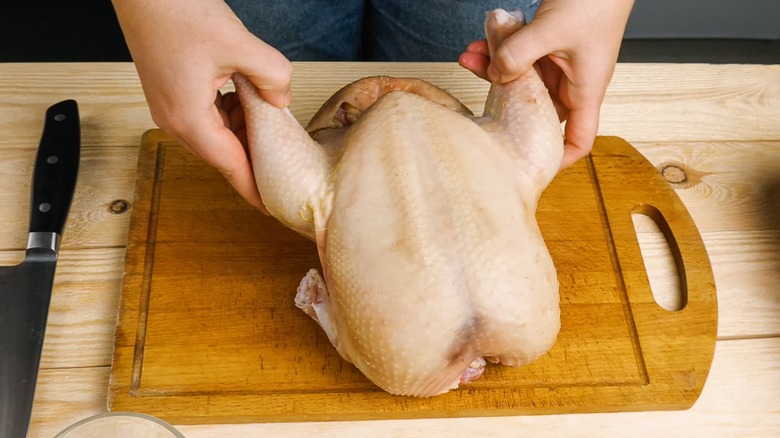Andrew Zimmern's Tip For Cutting Whole Chicken In The Right Place
Breaking down an entire chicken is something that any home cook can, and should, learn how to do. It's a great skill to know, to understand the anatomy of the bird better, and also to save money. Buying a whole bird and separating it into parts is a heck of a lot cheaper than buying pre-cut pieces. Few advocate this more than Andrew Zimmern, who explains via YouTube how to find the right spots on which to cut apart a chicken.
To start, you'll want to hunt for the joints on a chicken, and really any cooking bird, because it's way easier than cutting through bone. Plus, whenever you cut directly through bones, they may splinter into fragments which can get caught up in your cuts. When slicing through the joints, you make clean cuts straight through the connective tissue. As a result, you get nice, even, whole cuts.
There are many ways by which you can find the joint connections, but Zimmern makes this job simple and straightforward. He uses the weight of the bird to his advantage when it comes to locating the right place to cut, holding the wings and legs up with the heavy bird pulling down to reveal where the joint is, then snipping or slicing through it.
Use the bird's weight to your advantage
By holding the chicken by the joint you want to cut, Zimmern shows where the joints bend, and reveals the pasty white connective tissue beneath the skin. For the wing removal, Zimmern cuts through the connective tissue at two places: the wing tip and the ball and socket where the wing connects to the frame of the chicken. He slices the skin away and holds the chicken up by the wing and slices through the joint. The weight of the frame pulls the joint away from the frame, allowing you to see where to cut, and for it to come off easily.
For the dark quarters (leg and thigh), Zimmern points out that the only thing connecting them to the chicken frame is a wad of skin and the thigh joint. All he does is hold up the leg and slice into the skin. The thigh joint is then revealed and Zimmern separates it by pushing downwards and away from the frame. Then he follows the line of the backbone down to the oysters, and the dark quarter is removed.
The same principle applies to removing the breast from the backbone. Hold the breast section up, and slice between the top and base. This whole task takes a few minutes at most. In the end, you'll have a parted chicken, enough meat for several meals, and the frame bones to use for stock. What's not to love about learning to do that?

